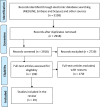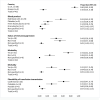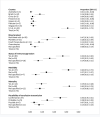Transfusion-transmitted arboviruses: Update and systematic review
- PMID: 36201547
- PMCID: PMC9578600
- DOI: 10.1371/journal.pntd.0010843
Transfusion-transmitted arboviruses: Update and systematic review
Abstract
Background: The detection of the first cases of transfusion-transmitted West Nile virus in 2002 posed a new challenge for transfusion safety. Institutions like the World Health Organization have stated that blood transfusion centers need to know the epidemiology of the different emerging infectious agents and their impact on blood transfusion. The aim of the study is to review the published cases of arbovirus transmission through transfusion of blood or blood components and to analyze their main clinical and epidemiological characteristics.
Material and methods: Systematic literature searches were conducted in MEDLINE, Embase and Scopus. Pairs of review authors selected a variety of scientific publications reporting cases of transfusion-transmitted arboviruses. Main clinical and epidemiological characteristics were reviewed of the cases described. The study protocol was registered in PROSPERO CRD42021270355.
Results: A total of 74 cases of transfusion-transmitted infections were identified from 10 arboviruses: West Nile virus (n = 42), dengue virus (n = 18), Zika virus (n = 3), yellow fever vaccine virus (n = 3), tick-borne encephalitis virus (n = 2), Japanese encephalitis virus (n = 2), Powassan virus (n = 1), St. Louis encephalitis virus (n = 1), Ross River virus (n = 1) and Colorado tick fever virus (n = 1). The blood component most commonly involved was red blood cells (N = 35, 47.3%; 95% confidence interval [CI] 35.9% to 58.7%). In 54.1% (N = 40; 95% CI: 42.7%-65.47%) of the cases, the recipient was immunosuppressed. Transmission resulted in death in 18.9% (N = 14; 95% CI: 10.0%-27.8%) of the recipients. In addition, 18 additional arboviruses were identified with a potential threat to transfusion safety.
Discussion: In the last 20 years, the number of published cases of transfusion-transmitted arboviruses increased notably, implicating new arboviruses. In addition, a significant number of arboviruses that may pose a threat to transfusion safety were detected. In the coming years, it is expected that transmission of arboviruses will continue to expand globally. It is therefore essential that all responsible agencies prepare for this potential threat to transfusion safety.
Conflict of interest statement
The authors have declared that no competing interests exist.
Figures





References
Publication types
MeSH terms
Substances
LinkOut - more resources
Full Text Sources
Medical

